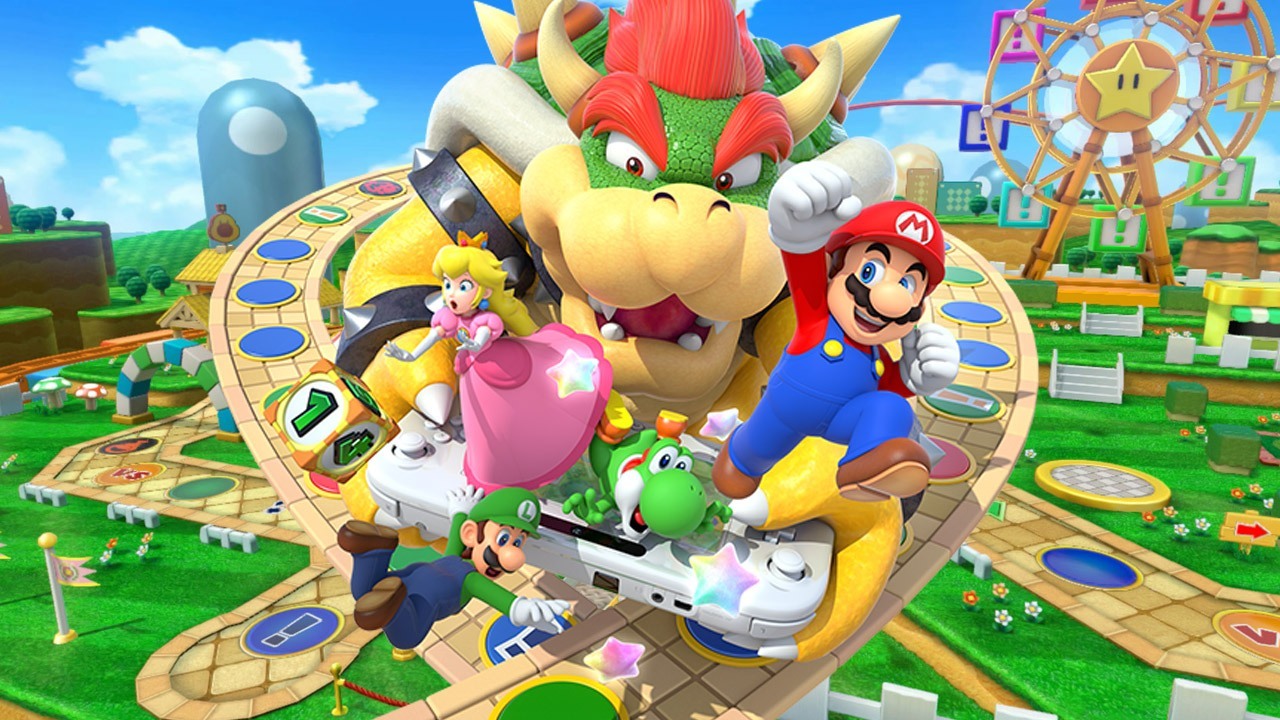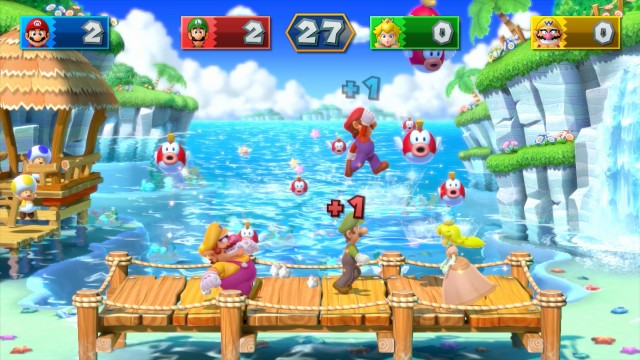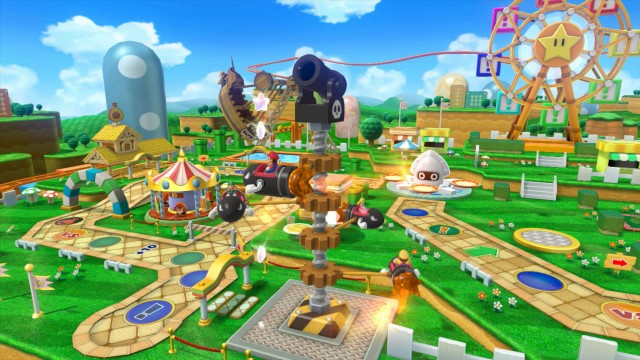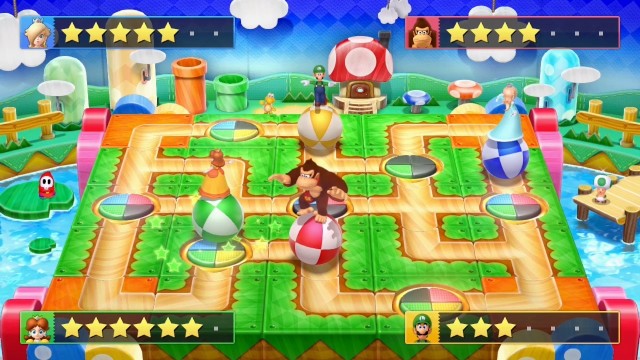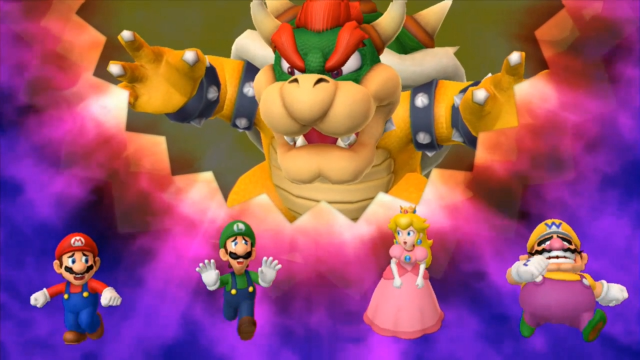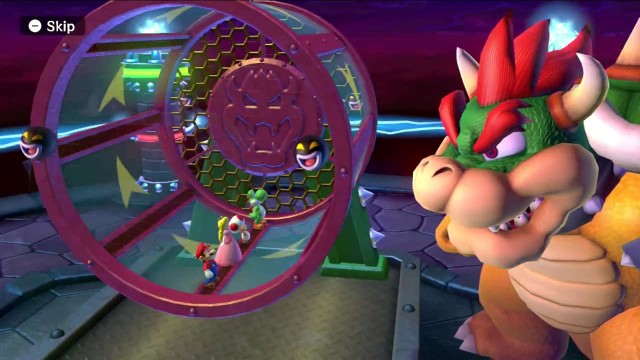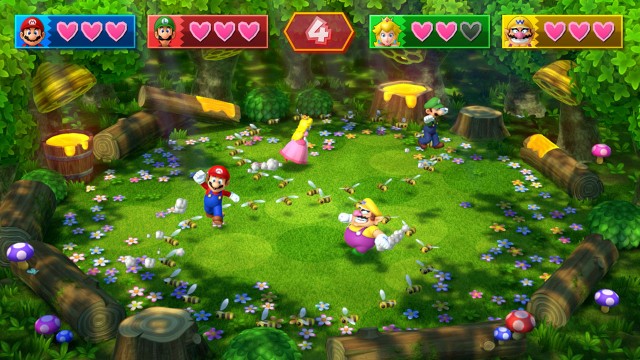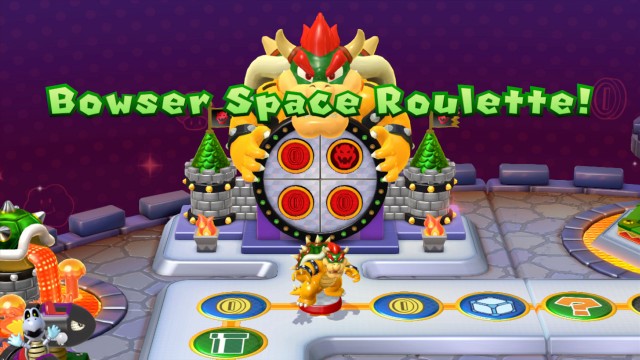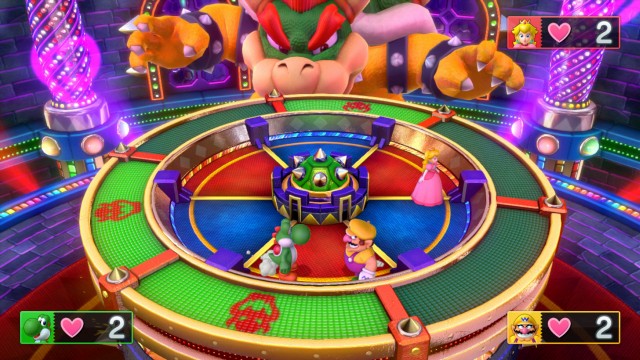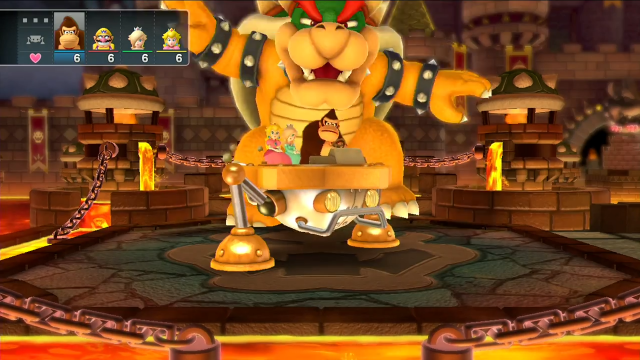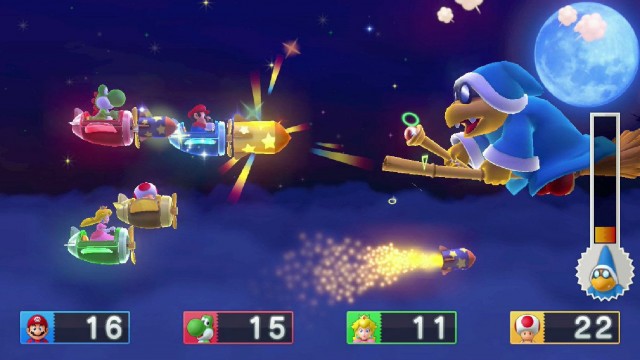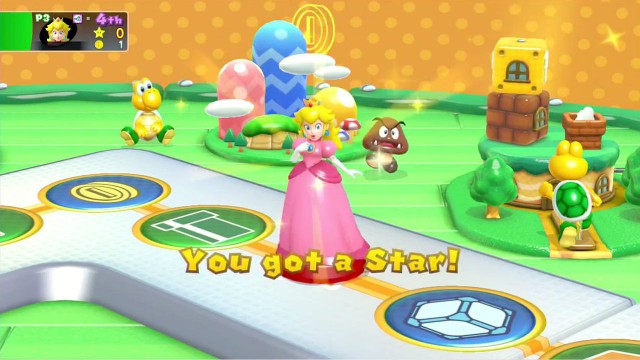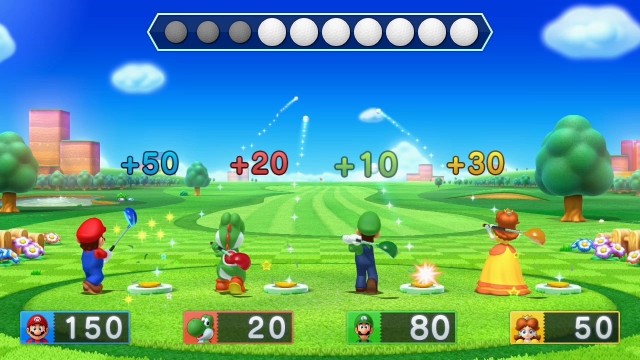Sixteen years later, and Mario’s still keeping the party going! While that’s certainly true of the cavalcade of highly successful mainline games and spin-offs that the portly plumber has provided on various Nintendo platforms since the turn of the millennium, it’s also true of the quite literal Mario Party series, which has just made its Wii U debut with Mario Party 10.
As much as it’s a milestone for Mario Party to hit double digits and make the jump to HD though, Mario Party 10 will end up being a surprisingly lukewarm celebration for many attendees. While the game can be fun with friends, as any Mario Party offering can, the ill-advised streamlining from Mario Party 9 seems to have made a comeback, and many of the new features are not as exciting as one would hope. It’s all functional, but it’s wanting for the ability to actually hold one’s attention beyond single, isolated play attempts every so often.
When Wii U owners already have incredible party-friendly games like Mario Kart 8 and Super Smash Bros. for Wii U readily at their disposal, Mario Party 10 just can’t keep pace, and that’s especially a shame in the jump to a new console. Young kids who no doubt won’t have an extensive play history of Mario Party are likely to be the most entertained, but adults who have stuck by this series since its inception on the Nintendo 64 will probably just shrug, and want to take out one of the series’ better legacy offerings instead.
Mario Party 10 isn’t quite as visually sharp as Super Mario 3D World or Mario Kart 8, but it still looks better than the series ever has before. The character models have additional details, the bright, colourful graphics are even more vibrant in HD, and there’s all sorts of interesting new animations and environmental effects added to the main game boards, which make them feel more lively than ever. That unique Nintendo polish is certainly all over Mario Party 10 as well, which feels like a colourful, friendly product throughout.
While it is a boost above the previous tier of visuals in the two Wii offerings though, and still manages to avoid the cheap budget look of some of the GameCube offerings especially, the move to Wii U doesn’t create as many graphical leaps as one may imagine. The game may look better than ever for the Mario Party series, but that’s relative, considering that Mario Party 10 still isn’t pulling out all of the stops with its graphics by any means.
Again, that’s not to say that the game looks bad, but considering how much effort another spin-off, Mario Kart 8 ended up putting into its models and environments, Mario Party 10 still looks a bit modest in comparison. The menus are pretty basic and uninteresting, the simplistic Amiibo Party boards look especially dull, and while all of the main party boards look lively and detailed in motion and from a distance, some of their finer elements barely look above Wii standards, which is disguised a bit by the HD makeover. Likewise, while most of the character models look good, they’re not quite as polished as these familiar characters have been in other Wii U games, missing some of the definition and animation detail that was previously there in other Mario branded games for the console.
Again, the younger and more casual players that Mario Party 10 seems to be directed at probably won’t notice these modest-tier Wii U visuals too much. More discerning Nintendo gamers however will likely feel like Mario Party 10, while visually solid, doesn’t stand with most of Mario’s previous HD appearances on Nintendo’s current console.
The janky, boppy musical stylings of Mario Party haven’t changed in Mario Party 10. The music tracks are serviceable, but none of them particularly impress, whether it be via minigames or via boards. There is an option to unlock the music to listen to at your leisure using Mario Party Points that you earn in-game for playing well and playing often, but this incentive is questionable, given that the soundtrack only has a few tunes that are all that catchy or interesting, especially when stacked up to superior Mario Party tracks from the series’ previous games.
Sound effects are also well-established for the tenth main entry in the Mario Party series. The cartoon-ish bops, hops, dashes and skids are all present and accounted for across the various minigames, just like the rolling and hitting of dice blocks sounds about the same as it ever did, with maybe a mite of added definition, due to the increased specs of the Wii U. Mario Party naturally isn’t rocking the boat with its audio presentation, and that includes the voice clips, which consist of the same exclamations and sighs of disappointment that most every character in the game has been uttering since the Nintendo 64 era.
The conservative audio presentation almost makes the game feel like the kind of party you would throw for school children, which may be fitting, given Mario Party 10’s target audience. It wants you to have fun, but not too much fun, lest you get too rowdy. We can’t have that, clearly.
Mario Party 10 is divided into three main modes, all of which are modes that you’re meant to gather your friends around with you to play. Mercifully, the game eliminates any pretense of a single-player mode, given the horrendous quality of these solo-driven modes in the past few Mario Party games, and instead sells its local multiplayer draw wholesale. Hopefully you have a small group of friends that wouldn’t mind playing with you, because Mario Party 10 has absolutely no appeal otherwise, particularly since the complete lack of online play still forces you to gather others on your game room couch with you to get any kind of party started.
Another important thing to note is that Mario Party 10 can only be played with Wii Remotes for the most part. You’ll need a Wii Remote for each player (fortunately, it doesn’t necessarily need to be a Wii Remote Plus), which may be predictable for a multiplayer-driven Wii U game like this, but the complete lack of Wii U Pro Controller and Wii Classic Controller support may be less predictable for some. Even in the series’ move to Wii U, Mario Party 10 remains all about motion controls, though thankfully, there are plenty of games where you simply hold the Wii Remote sideways and use like it an old-school NES controller, sharply reducing the likelihood of playing broken, crummy minigames that shoehorn motion controls for their own sake, as was more of an issue in Mario Party 8 and Mario Party 9.
The Wii U Gamepad is still utilized in one particular mode however, and that’s the all-new, and very inspired, Bowser Party! In this mode, one player takes control of Bowser, who is controlled with the Wii U Gamepad, while up to four other players pick up Wii Remotes, and take control of the familiar Mario Party personalities. The four Wii Remote players must move along the game boards, trying to flee from Bowser, who has multiple dice blocks, and can eventually catch up with them. Players are thrust into an extra-deadly Bowser minigame every time the Wii U Gamepad user catches up with them, which will threaten their counts of Hearts. Bowser’s job is to reduce every player’s Hearts to zero in order to win the game, though if even just one player reaches the end of the board successfully, the other four players are winners.
The idea behind Bowser Party is excellent, and makes for one of the best uses of the Wii U Gamepad since Wii U launch title, Nintendo Land! Unfortunately, the reduced count of Bowser minigames, and the fact that you can only play Bowser Party on three of the five available game boards, does hurt the appeal of the experience a bit. Likewise, depending on the skill of the Bowser player and/or the other four players, there can be some balance issues amongst certain groups, especially if Wii Remote players are forced to pair up with the sometimes-dodgy A.I. Unlike Mario Party 9, you’re once again forced into groups of four in any given game mode, not just Bowser Party.
Still, some of the Bowser Party ideas are where Mario Party 10 becomes its most strategic. Bowser players can draw paths to try and tempt (or bluff!) players into taking disadvantageous paths through black mists in the Whimsical Waters board for example, as obscured paths on the television are revealed on the Wii U Gamepad Screen. Likewise, Bowser players can set flamethrower traps that may burn and damage players unseen on the Chaos Castle board. This is where the most fun of playing as Bowser lies, even if it’s also enjoyable to watch your friends fail at Bowser’s cheekily rigged minigames, if they’re wont to fall for your trickery when playing as the Koopa King.
This leads to one of the biggest issues with Mario Party 10’s selection of party boards however, and that’s that they’re once again linear and largely uninteresting plods through to the same destination. Unfortunately, one of Mario Party 9’s worse ideas, the idea of sticking players together on a single ‘party bus’ that moves along a largely linear path, is back in Mario Party 10. Thus, if you were hoping for a return of the big, sprawling, multiple path-laden boards from the series’ finest Nintendo 64 and GameCube offerings, you’re sadly out of luck here. The linear boards may streamline gameplay a bit, but they also make the game less fun and interesting for anyone taking it seriously.
Making matters worse is the fact that Mario Party 10 now demands that players land on dedicated Minigame Spaces, or trigger hidden Minigame Blocks, to play any of the minigames on offer. This is downright baffling, since it’s sometimes possible to play entire board game sessions without a single minigame!
Worse still is that the minigames in Mario Party 10 are a pretty considerable step up in quality from the series’ previous two Wii offerings, even if they’re still pretty uncomplicated for the most part, and there’s still a couple that aren’t very fun. Still, some of the minigames can be very amusing, such as a free-for-all minigame where players have to push each other out of the way to pose for a photo, or a game where two teams have to co-operate to stack blocks as high as they can, and make sure they don’t fall over. For young kids, or a band of slightly drunk adults, these minigames can be a real blast!
Still, all of this is somewhat sunk by the series’ usual flaw continuing to rear its ugly head with every recent installment, including this one; Mario Party 10 is more based on luck than skill. This is well and good for young kids and/or casual players who just love reveling in the company of friends, but again, to anyone who is trying to challenge each other and make the game more competitive, they’ll probably become very annoyed, very quickly.
The way that the tide of the game can turn so abruptly can make for unpredictable and loose party hijinx if you’re just screwing around, but it also makes playing against the A.I. a huge chore, and makes Mario Party 10 feel rage-inducing and unrewarding in too many circumstances. Even if you spend the entire game with a commanding lead, it’s possible that it could all be taken away from you arbitrarily at any time, knocking you down to 3rd or 4th as late as the last turn, and that’s enough to have you angrily chucking your Wii Remote through the TV, if you’re actually playing to win.
Mind you, there’s no solo mode that demands you actually care about the results. Surprisingly though, playing well earns you Mario Party Points, as I said, along with in-game achievements called ‘Challenges’, which keep a record of your most noteworthy accomplishments in the game. Mario Party Points can be spent on unlockable characters, new skins for the party bus, music tracks, and a few other extras. They’re given to you even if you lose, though naturally, you’ll get more if you win. There’s limited incentive to actually unlock everything, but at least the developers tried to create some sort of reward for playing successfully, which only mostly leaves Mario Party 10’s results forcing you to submit to the whims of Lady Luck.
The best way to recall classic Mario Party gameplay in Mario Party 10 is to play the Amiibo Party mode, though naturally, this requires owning at least one Amiibo figure. Fortunately, the Super Mario set of Amiibo that Mario Party 10 supports are all pretty common at retail stores (except for Toad, seemingly), and there’s even a bundle that packages a Super Mario set Mario Amiibo with the Mario Party 10 game itself. The Super Smash Bros. set Amiibo from the Mario franchise also work in lieu of their Super Mario set counterparts, though you’ll need to erase data from the Super Smash Bros. games if you want to use these Amiibo figures in Mario Party 10, unfortunately.
Anyway, you scan an Amiibo for each player, of up to four (player absences will be filled by cardboard cutouts controlled by the A.I.), and then choose a themed board, which can be selected from any Amiibo available for Mario Party 10’s playable characters. If any player opts to scan a Bowser Amiibo for use in Amiibo Party, whether from the Super Smash Bros. set or the Super Mario set, the entire group will also be forced to play Bowser minigames at the end of every series of turns, instead of the normal minigames, complete with the Bowser user having to use the Wii U Gamepad in minigames, a la Bowser Party. The Bowser player will also be immune to the effects of Bowser Spaces, and will even benefit from landing on a Bowser Space, while other players would suffer for it.
As with the classic Mario Party games, the goal of Amiibo Party is to simply see who can collect the most Coins, and use them to buy the most Stars, after 10 turns. It sounds like a great throwback to better days for the Mario Party series, but sadly, every board is just a simple, tiny square, with only slight variations in event spaces and bonuses, depending on which Amiibo you scanned to create the board. On top of being boring, Amiibo Party also quickly gets annoying, since you have to have the Wii U Gamepad easily accessible for every player on every turn, Bowser player or no, on account of having to tap your Amiibo on the Wii U Gamepad’s NFC reader whenever any human player’s turn rolls around. This just feels like an inexplicable design decision, especially if your game room setup doesn’t give you any reasonable means to have four different people be in grasping distance of the Wii U Gamepad, and frankly, most people’s gaming areas won’t. It feels like the developers didn’t totally think Amiibo Party through, frankly.
There are a few bonus games stashed here and there in the game’s menus, such as a simplistic badminton button-matching game, or a reasonably enjoyable, physics-driven Tetris-style gem-matching game, but like pretty much everything else in Mario Party 10, these won’t hold your attention for very long. Even in the series’ Wii U debut, its latest offering still feels too unremarkable and shallow to get too much out of. Undemanding, uncaring players can have some fun with Mario Party 10’s handful of amusing mayhem, but the fun and novelty wears off, no doubt at the same rate that the necessary alcohol buzz that serious-playing adults will require to get the most out of the game will.
Mario Party 10 has its moments of chaotic fun for people who want an undemanding multiplayer game to play on their Wii U, but it still brings far too many of the series’ stubborn flaws back to the table yet again. The experience is still far too dictated by the whims of chance, the depth that this series once boasted is still gone in the streamlined, dumbed-down party boards and modes, and the lack of a sense of worthwhile rewards hurts the lasting value, especially when more serious Wii U gamers can get a lot more out of multiplayer sessions of Mario Kart 8 and Super Smash Bros. for Wii U.
On the bright side, Mario Party 10 is a solid, relaxed game for kids, and people who aren’t that serious about video games. Those people won’t mind the virtual lack of control over the game’s results, and nor will adult players who are playing it as a simple drinking ritual with their buddies. If you’re looking for anything more than a disposable good time though, Mario Party 10 is left wanting, and feels like a missed opportunity to make the series more appealing to play, given this being its debut offering on the Wii U.
Fortunately, if you’re looking for a more strategic and rewarding Mario Party game, Wii U owners readily have access to the first couple of Nintendo 64 games for just $10 each, thanks to the Wii Virtual Console selection that’s available to them. In that case though, Mario Party 10’s half-baked bag of tricks isn’t enough to make it a truly compelling bash for longstanding Mario Party guests. The latest game in the series may attempt interesting new ideas in Bowser Party and Amiibo Party, which are ripe to be expanded upon in a seemingly inevitable Mario Party 11 to come, but for now, they’re shells of what they could be.
Like that high school Spring dance you used to put so much stock into, there’s a young, less discerning audience for Mario Party 10, but those that are used to the party scene will still have long outgrown what it’s offering.

